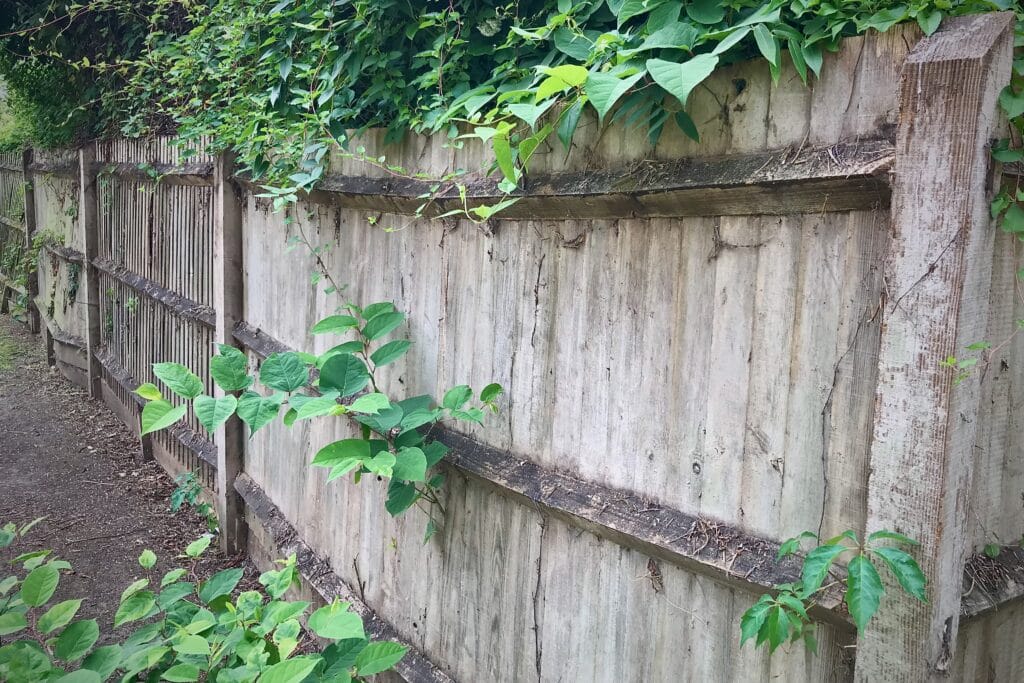In recent years, the landscape of Japanese knotweed in UK legal proceedings has seen a surge in successful claims. Notably, Japanese Knotweed legal cases have established important case law precedents. However, they have also broadened the scope of scenarios where legal action can be taken. Many of the law cases involving Japanese knotweed have gained significant media attention in the UK, elevating the profile of this type of litigation amongst homeowners, surveyors and developers. Evolving UK case law continues to play a pivotal role in shaping litigation procedures, particularly in instances where remedies are sought through private nuisance.
Impact of Japanese Knotweed Case Law
In English law, ‘nuisance’ is an area of tort law broadly divided into two:
- Private nuisance
- Public nuisance
Japanese Knotweed legal cases involving encroachment, typically fall into the realm of private nuisance. However, in recent cases there has been broader discussion about which of the three kinds of private nuisance should be applied:
- Encroachment onto neighbour’s land
- Physical damage to the land itself
- Interference with the amenity of the land (right to use and enjoy)
Significantly, there has been a change of focus to loosing the ability to use and enjoy the land, seen as a loss of amenity. Whilst prior cases, such as Leakey v National Trust for Places of Historic Interest or Natural Beauty [1980], had already established that it is not acceptable to ‘doing nothing’. Once aware of the nuisance reasonable steps should be taken to resolve it.
Precedence has now been set within case law, that the owner of the land subject to Japanese knotweed can be held liable for common law private nuisance. Neighbouring landowners affected can claim for a range of damages beyond merely the physical damage caused by knotweed growth.
Landowners now risk claims that include defendant liability for loss of enjoyment and a diminution in property value. This could be in addition to actual property damage, costs of invasive species removal, and a continuing injunction to prevent re-infestation. 2023 cases have provided further clarity to the duties of landowners. More markedly, they have established neighbouring landowners’ rights regarding the presence of invasive species, and the impact they might have upon their property.
Japanese Knotweed Legal Cases
The high profile cases that made their way to the Court of Appeal have had important impact on claims. Typically, the focus has been dealing with Japanese knotweed encroaching on properties from neighbouring land. There have been many instances of solicitors winning compensation for this. Several councils have paid out, including Croydon Council and Preston Council, paying sums between £10,000-£27,000 in damages.
However, newer Court of Appeal cases have led to other impacts of Japanese knotweed being acknowledged. The legal implications of finding knotweed on your property have broadened.
The following three cases have led to significant changes in case law:
Williams v Network Rail Infrastructure Ltd [2019] QB 601
Network Rail Infrastructure Ltd v Williams & Waistell [2018] proved to be a groundbreaking Japanese knotweed case. Mr. Williams and Mr. Waistell, the neighbours, initiated claims against Network Rail and were awarded significant damages. The claimants were to receive:
- £4,320 to each Claimant to cover an insurance backed treatment package;
- £300 to Mr Waistell for the costs of a knotweed survey;
- £350 general damages per year (total £1,400 for loss of amenity and interference with quiet enjoyment;
- £10,500 to Mr Williams and £10,000 to Mr Waistell for residual diminution in value once the treatment was completed.
However, this decision was appealed by Network Rail Infrastructure Ltd.
Background:
The 2019 Court of Appeal decision in the case of Williams v Network Rail Infrastructure Ltd marked a significant development in landowner liability for Japanese Knotweed. The claimants, owners of bungalows adjacent to Network Rail’s land, brought forward two key claims:
- An ‘Encroachment Claim’ regarding the spread of Japanese Knotweed roots under their properties
- A “Quiet Enjoyment/Loss of Amenity Claim” based on the interference with the quiet enjoyment and amenity value of their properties.
Verdict:
The recorder initially dismissed the ‘Encroachment Claim’ but favoured the claimants’ ‘Quiet Enjoyment/Loss of Amenity Claim’. The judge held that the presence of untreated Japanese Knotweed on Network Rail’s land constituted a stigma, diminishing property value and a blight causing loss of enjoyment. Network Rail was found to have constructive knowledge of the risks associated with Japanese Knotweed. Knowing this, they had not taken reasonable steps to prevent interference with the claimants’ properties.
However, the Court of Appeal disagreed with the recorder’s extension of nuisance to a claim for pure economic loss. The court rejected the notion that the mere presence of Japanese Knotweed might lead to private nuisance claims. However, the court acknowledged that landowners must still take reasonable steps to prevent or minimise encroachment.
Precedent Set:
The Court of Appeal’s decision in Williams v Network Rail emphasised that a nuisance claim based on encroachment of Japanese Knotweed rhizomes can be actionable. It imposes an immediate burden on neighbouring landowners intending to develop their land. The case clarified the scope of landowner liability, emphasising the duty to take reasonable measures against encroachment. While rejecting claims solely for economic loss, the decision reinforced the importance of protecting the use and enjoyment of land from the impact of Japanese Knotweed.
Davies v Bridgend County Borough Council [2023] EWCA Civ 80
In the case of Davis v Bridgend County Borough Council [2023], the council’s land had Japanese knotweed growing on it for some time. The estimate being, for over 50 years. Although the aerial parts of the plants had been treated the roots remained, which meant the plant had not been sufficiently eradicated.
Background:
Although concerned about the knotweed for sometime, Mr. Davis first complained to the council in 2019.
Mr. Davies initiated a claim against the council, declaring that the persistent presence of Japanese knotweed had caused a diminution in the value of his property. This was in spite of the fact of the fact that Bridgend Borough Council had started their treatment of the plant in 2018.
In the first instance, the district judge found that there had been a breach of duty. However, following the case of Williams v National Rail (2018) (Williams), concluded that diminution in values damages weren’t recoverable. Mr Davies subsequently went on to launch two appeals.
Verdict:
In the second appeal, the judge explained that the judge in the first instance had misinterpreted the Williams case. Significantly, it was stated in this Japanese Knotweed law case, that there was no need for the claimant to demonstrate that the invasive plant caused a risk of damage to structures. Or, that there was an increased difficulty in developing the land. The persisting encroachment of the plant onto Mr Davies’ land was held to be a ‘continuing nuisance’. As such Mr Davies was entitled to damages representing the diminution in the value of his property.
Precedent Set:
Although diminution in property value caused by knotweed was argued by the council as being an issue of pure economic loss that cannot be claimed as part of a private nuisance claim. The appeal decision states that it can, establishing new precedent that further defines this new area of property litigation within nuisance tort.
A second precedent that will shape the future of litigation in cases including Japanese knotweed is on the issue of causation. The council had argued that ‘if knotweed had encroached well before it [the council] knew the plant posed a significant property risk, then it couldn’t have caused that risk’. However, it was established in the latest appeal that the date that the council should have known about the risks was 2012, the year the RICS information paper was published.
The failure of the ‘constructive knowledge’ argument in the latest appeal means that any claims where Japanese knotweed was found to be encroaching before this date are now much more likely to succeed. Certainly any claims where knotweed was found and nothing done to prevent encroachment onto neighbouring land post 2012 will cite negligence of up to date RICS information as a mark against the defendant. The outcome of this latest appeal means that claimants’ lawyers now have two significant precedents to bolster their clients’ cases.
Downing v Henderson (2023)
In 2023, Downing v Henderson contributed to the ongoing evolution of case law surrounding claims related to Japanese knotweed. This time the focus of the case was not based on property encroachment, but instead the completion of the TA6 property information form.
Background
In this case, the vendor of a residential property marked ‘no’ on the TA6 property information form. This was specifically addressing whether the property was affected by Japanese Knotweed. This form, post-February 2020, requires vendors answering ‘no’ to be absolutely certain. Consequently, it is now advised for vendors to respond with ‘Not known’, placing the onus on purchasers to verify the status through a Japanese knotweed survey.
Verdict:
In the case of Downing v Henderson, the buyer discovered a substantial presence of knotweed in the garden, challenging the ‘no’ response on the TA6 form. The defendant lost the case, and the claimant successfully secured damages against the seller. The Judge determined that the seller ‘did not genuinely believe that the property was not affected by knotweed at the time it was sold’. Evidence revealed that the vendor had previously instructed treatment for Japanese knotweed. The ‘no’ on the TA6 form was consequently deemed fraudulent. Similar to other cases, the damages awarded were linked to the property’s diminished value rather than physical damage caused by plant growth.
Precedent Set:
Downey v Henderson sets a new precedent by highlighting the importance of truthful responses on property information forms, specifically regarding Japanese knotweed. The case underscores the legal consequences of fraudulent declarations, especially when evidence suggests prior knowledge or treatment of the invasive plant. This decision further emphasises the shift in liability and advises vendors to respond cautiously, recognising the potential legal implications. Downey v Henderson contributes to the dynamic landscape of Japanese knotweed case law, shaping guidelines and expectations within the property industry.
Pember v Transport for Wales [2023]
A homeowner, Mr. Pember, pursued Transport for Wales’ based on an inconsistent knotweed treatment plan that allowed the invasive plant to encroach on his property.
Background:
In this instance there had been treatment, but it wasn’t executed consistently, resulting in the invasive plant encroaching onto Mr. Pember’s property. Previous legal precedents, including Network Rail vs. Waistell, played a crucial role in validating the claimant’s position. The threat to property value and the ongoing financial burden of knotweed treatment were considered substantial factors in this case.
Verdict:
The court awarded Mr. Pember £10,000 in damages due to the inconsistent knotweed treatment plan by Transport for Wales. Transport for Wales attributed the verdict to missing paperwork and asserted the thoroughness of their treatment programs. However, the court’s decision signalled the need for more effective control measures against the continued encroachment of Japanese knotweed.
The victory in Pember’s case emphasises the importance of holding responsible parties accountable for preventing the spread of such destructive plants. The damages awarded not only compensate tangible losses but also underscore the need for proactive measures in addressing invasive species.
Precedent Set:
Pember v Transport for Wales adds to the growing precedent that recognises the serious implications of inconsistent knotweed control measures. The court’s acknowledgment of the threat to property value and the enduring financial burden sets a standard for future cases. A clear message was sent about the legal consequences of insufficient measures, encouraging a proactive approach to safeguarding property values and mitigating the impact of Japanese knotweed.
Adam and Eleanor Smith v Rosemary Line (2018)
In a property transaction with Rosemary Line, Adam and Eleanor Smith acquired a residence in Falmouth, Cornwall. Despite the Smiths’ early attempts to address Japanese knotweed on both properties, Mrs Line’s inadequate action led to subsequent litigation.
Background:
In 2002, Adam and Eleanor Smith purchased a property in Falmouth from Rosemary Line. As part of the transaction, Mrs. Line retained ownership of a neighbouring piece of land. Subsequently, Japanese knotweed emerged on both the Smiths’ and Mrs. Line’s properties. Despite the Smiths’ efforts to address the invasive species shortly after purchasing the property, minimal action was taken by Mrs Line, leading to eventual litigation.
Verdict:
The case, heard in Truro Country Court in October 2017, revealed Mr. and Mrs. Smith’s belief that the presence of Japanese knotweed on their property devalued it by approximately 10%. Mrs. Line’s lack of cooperation in the lead-up to the court hearing, including non-responsiveness to solicitors’ correspondence and delayed document production, influenced the proceedings. Satellite images presented as evidence showcased the invasive plant’s spread, contrary to Mrs. Line’s claims of taking steps for its removal.
Precedent Set:
In early 2018, the judge’s ruling set a precedent by ordering the removal of Japanese knotweed and directing Mrs. Line to engage the Local Authority contractor for a five-year eradication plan. The judge also awarded court costs to the Smiths, estimated to be in the tens of thousands of pounds.
The landmark decision reinforced the principle that whilst having Japanese knotweed on your land is not be illegal. However, allowing its unchecked spread constitutes a violation of the law. The case highlights the legal obligation to address and control the growth of invasive species.
Case Law Involving Japanese Knotweed
As more claims are brought forward that refer to actionable private nuisance, the case law generated helps to define the parameters by which claimants will be successful. Thanks to precedents set in the aforementioned cases it is now easier for legal advisors to structure a claim with a view of gaining a positive resolution for the claimant.

Japanese knotweed encroachment from neighbouring property
PBA Solutions undertakes site surveys which document and report the findings. You can book a Japanese knotweed survey here. It will provide formal identification, an accurate record of where the knotweed is located and the most appropriate methodology for control or removal.
For further help and information concerning plants mistaken for Japanese knotweed, call our team on 0203 174 2187 or 01202 816134.

